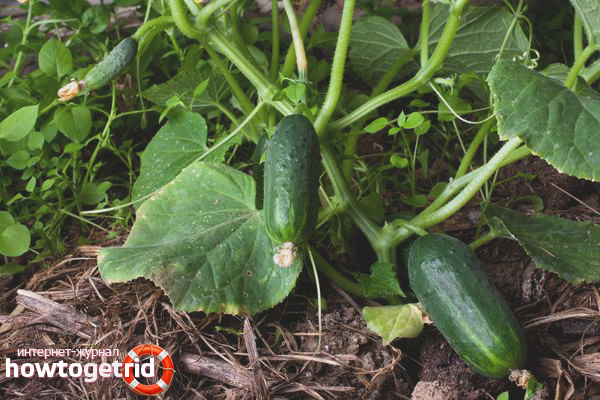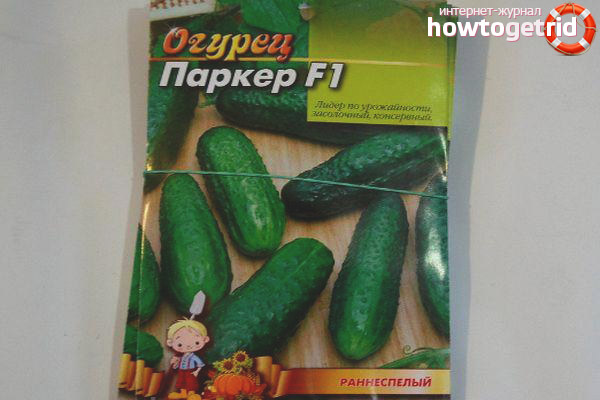The content of the article
The cultivation of cucumbers is very popular in our country. In every garden there are beds with this useful vegetable crop. To date, many varieties are bred, each of which has its own individual cultivation features.
The Parker cucumber variety is resistant to high air temperatures. It was entered into the State Register for cultivation in the southern regions of the country, but it is also successfully grown in other areas. Plants grow well and develop in open beds, in greenhouse constructions, and also under film shelter. The variety belongs to the hybrid group, which explains its high productivity and unpretentiousness to climatic conditions.
Grade description
Bushes of plants are strong and powerful. Fruits are formed by the female type of flowering, have the same size. The variety is not self-pollinating, therefore, the intervention of bees is required. The bushes have medium branching, leaves are slightly wrinkled, gray-green color. Ovaries form after 4-5 leaves, from 1 to 3 fruits are present in one ovary.
The shape of the fruit is cylindrical oval. The surface of the skin is green in color, coarse tuberous with white spikes. The presence of white stripes is observed. The pulp of the fruit is dense, does not have a bitter taste. Thanks to the dense skin, cucumbers are well transported over long distances. Overripe fruits do not turn yellow, and do not lose their taste. Vegetables grow in length from 9 to 12 cm. The average weight of one adult cucumber is about 110-120 grams.
The fruiting period lasts from June to October. Subject to the rules for care, you can get a good harvest, with one square meter it turns out to collect up to 11 kg of cucumbers. When growing in closed ground, it is necessary to provide access to bees for pollination of plants.
Planting varieties
The land is fertilized with humus in the fall and the beds are dug up. If this was not possible, then the procedure is performed before planting seeds in the spring. To do this, you need to make furrows in the soil, and fill them with sand, humus and mineral additives. After this, the bed should be watered abundantly. Seeds are laid to a depth of 2-4 cm. Top cover with polyethylene. Between adjacent plants, leave 50 cm of free space.
For a greenhouse or greenhouse, a seedling method of growing cucumbers is preferable. Sowing seeds is carried out in March. Ready seedlings are planted in mid-May, at the phase of formation of 3-5 true leaves.
Seed preparation
Hybrid varieties do not involve self-collection of seeds. Plants do not preserve maternal genes, so they must be purchased in specialized stores. Seed germination lasts up to 7 years. Prepare seed for planting should begin in about 30 days. At this time, you need to warm the seeds and harden. First you need to select the suitable ones. To do this, they are placed in saline solution (1 teaspoon of salt in a glass of water). After that, the empty shells rise to the surface, they need to be thrown away. Suitable seeds will sink to the bottom.
The selected seeds must be dried and refrigerated.After a while, they are removed from the refrigerator, and put in a warm place. Before planting on seedlings or in the soil, the seeds are treated with a weak solution of potassium permanganate for disinfection. They can also be soaked about a day before planting in water, wrapped in gauze. This will help faster germination of sprouts.
Bed under the film
This planting method is suitable for open ground and for greenhouses. The bed should have a level surface, be in a place protected from winds and drafts. The length of the ridge does not matter, and in width it is preferable to make it no more than 1 meter. Last year's straw and humus are poured on top of the prepared area. In the process of organics overheating, heat is generated. From above it is necessary to fill everything with a layer of earth.
After about 7 days, you can plant seeds or seedlings. Landings from above are covered with a film. On good sunny days, shelter is removed, and with the onset of the evening, the beds are covered again. To fix the covering material, bricks or stones are used. The film is crushed from all sides by a load. With the establishment of warm weather and when the sprouts get stronger, the film is removed.
Care Features

Cucumbers are very fond of good hydration. Drying of the soil should not be allowed, this can negatively affect the harvest. It is necessary to water the plants after sunset or early in the morning with warm, settled water. It is best to choose drip irrigation for this. For cucumber varieties, it is very important that the water does not fall on the foliage, otherwise it may begin to dry out. Drop watering will saturate the root system with moisture, and the leaves will remain dry. After watering, it is recommended to loosen the soil. This should be done carefully, the roots of the bushes are close to the surface of the earth, they can be easily damaged. If the soil under the plants is mulled, then loosening is not required.
Be sure to periodically remove weed grass. Weeds carry dangerous viruses and pests, and also take away from the soil the nutrients necessary for the culture to grow and develop. During the summer period, it is recommended to make additional nutrition for cucumbers in the form of mineral fertilizers. This is especially important to do during the flowering period and during active fruiting.
Diseases and pests
Pre-treatment of seeds enhances the resistance of the variety to diseases such as olive spotting, mosaic virus and powdery mildew. Hybrids and so have good innate resistance to various fungal infections. It is not recommended to plant cucumbers after a pumpkin or after zucchini. If nevertheless there was a nuisance, and one of the diseases struck the bushes, it is necessary to remove the affected leaves and conduct treatment with an insecticidal agent. Pests can be scared away if you plant strongly smelling herbs or plants next to cucumbers. For example, plant onion, dill or garlic between rows.
The Parker cucumber variety is versatile. Cucumbers are consumed fresh, used for salads, various preparations are made from them. Unpretentious variety does not require difficulties in maintenance. Many gardeners appreciated the positive characteristics, and constantly grow it in their areas.
Video: F1 Parker cucumbers










Submit